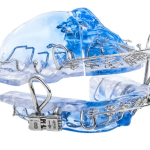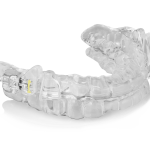A study published in Annals of the American Thoracic Society demonstrates a promising new method for titrating oral appliances in the treatment of obstructive sleep apnea (OSA). The study tested Sunrise’s mandibular jaw movements automated analysis.
Though clinicians should perform follow-up sleep evaluations to verifiably assess the effectiveness of OSA treatments, costs and logistical challenges can reduce the practicality of such follow-up tests for patients using oral appliances.
This observational, prospective study by Jean-Louis Pépin and co-investigators involved 135 OSA patients and compared mandibular jaw movements automatic analysis via Sunrise’s chin-based sleep test as an alternative to traditional polysomnography for oral appliance titration.
Automatic analysis using mandibular jaw movements was compared to in-lab polysomnography (PSG) for baseline (diagnosis) and polygraphy (PG) for the final titration, which is the standard of care for reimbursement in Belgium (where the study was conducted).
Both PSG and PG were conducted in the same laboratory and PG was supplemented with video surveillance and peripheral actigraphy to best estimate sleep time; it was then verified that total sleep time had not biased the comparison of the indices.
The automated mandibular jaw movements (MJM) analysis demonstrated strong agreement with PG in assessing AHI at the end of titration, with a median bias of 0.24/h. The improvement of the apnea-hypopnea index from baseline in response to oral appliance treatment was consistent across three evaluation conditions:
- in-laboratory PG,
- in-laboratory automated mandibular jaw movements analysis, and
- at-home automated mandibular jaw movements analysis.
“The simultaneous PSG/PG and measurements at the beginning and end of the study period are a major strength of this study and demonstrated agreement between MJM analysis and PSG/PG,” says Laurent Martinot, CEO at Sunrise.
“This innovation promises a more accessible and patient-friendly approach to managing OSA, paving the way for broader adoption and better patient compliance.”




Leave a Reply